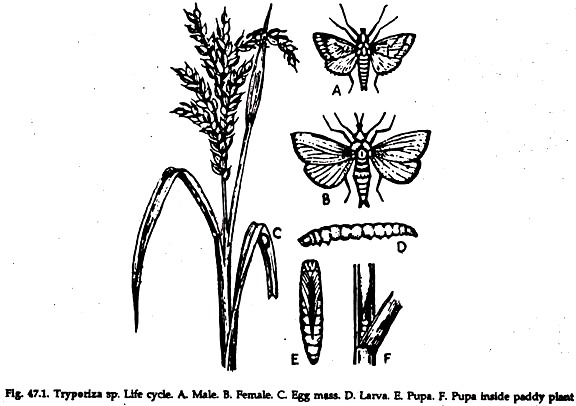In this article we will discuss about:- 1. Behaviour, Ecology and Control of Tryporiza 2. External Features of Tryporiza 3. Life Cycle.
Behaviour, Ecology and Control of Tryporiza:
1. The lepidopteran insect (moth) Tryporiza, locally named Mazra poka’ is a common paddy pest. Its larvae bore into the stem tissue, hence it is called stem borer (Fig. 47.1).
2. It has a wide range of distribution and is found in all the paddy-producing states of India, viz., West Bengal, Bihar, Orissa, Uttar Pradesh, Madhya Pradesh, Karnataka, Andhra Pradesh, Kerala, Assam and others.
ADVERTISEMENTS:
3. The larva (caterpillar) bores into the stem at a lower point of the plant.
4. It cuts the central shoot, which turns yellow and dies, and no grains are produced.
5. Infestation occurs through the year, the peak is in September-October period.
External Features of Tryporiza:
1. The males are smaller in size.
ADVERTISEMENTS:
2. The wings are yellow in colour.
3. In females, a distinct black spot is present-on the forewing.
Life Cycle of Tryporiza:
1. The female moth lays about 150-300 eggs in phases on the lower, surface of paddy leaves.
2. Usually the egg mass is covered by buff colour hairs.
ADVERTISEMENTS:
3. The eggs are greyish-white with sculptured surfaces.
4. The larva hatches out within 6-8 days depending on temperature, moisture etc.
5. The caterpillar larva makes a small bore in the stem devouring the tissue.
6. In 4-5 weeks within the stem it is about 2 cm long.
7. A full-grown larva is faint yellow, with a yellowish-orange chitinoid head, three thoracic and twelve abdominal segments. The larva may leave the original plant and attack a few more plants before pupation.
8. The larva pupates within the stem. Before pupation it makes another hole on the plant for escape after emergence from pupa.
Management:
1. Physical:
(a) Light trap with persistent insecticides,
ADVERTISEMENTS:
(b) Rotation of crops,
(c) Hand-picking and destruction of infected plants are somewhat effective.
2. Chemical:
Laying of eggs on the undersurface of the leaves keep the eggs out of sight. Immediately after hatching, the larvae enter paddy plants and remain protected there. But the larva often leaves the original plant and attacks a number of plants one after another.
Advantage of this behaviour is taken far chemical control.
a. Spraying of water soluble BHC and other insecticides are of limited use since the chemicals usually do not reach the eggs on the undersurface of leaves.
b. Poisoning of water in the field with systemic insecticide is quite effective as the larvae come in contact with water in their way from plant to plant.
